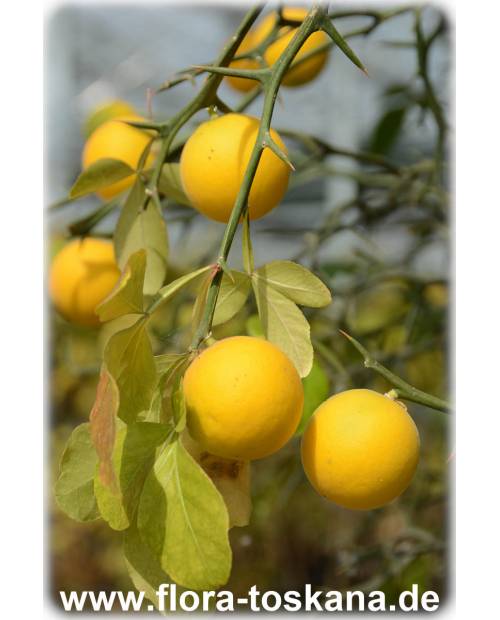











































































BESTSELLER (rank 12) - Orange trees in our gardens? That's not possible! But it is: the robust Trifoliate Orange shrubs or small trees (Poncirus trifoliata) are hardy and provide you with a harvest of yellow-orange, decorative orange fruit in fall.
Trifoliate Orange (Poncirus trifoliata) is native to the Himalayas (central China). From there it has brought its high cold tolerance (see below), which makes it the only citrus plant suitable for gardening in northern Europe so far. Young Trifoliate Oranges are fast growing, later moderately. They branch off well, which can be even improved by cutting long, upright growing branches. Branches have stiff thorns, making the plant look like growing in a zigzag. The three-part leaves, which give the species its name, differ completely from other citrus plants. Because the roots are robust and well-branched (other citrus plants prefer to form long taproots), Trifoliate Oranges are very suitable for pot culture and are often used as a cold-hardy rootstock for grafting other citrus varieties. The flowers are large, 4-5cm across, their five petals clearly separated at the base. Young fruits are slightly furry. The initially green peels turn light to dark yellow when fully ripe. The fruits contain little pulp and many seeds, so that they are only of little value for use. However, they are a very nice decoration for your garden. When planted in the garden, Trifoliate Oranges can resist temperatures down to about -20°C, depending on the location, age and constitution of the plant. Therefore, empirical values vary between about -15°C and -25°C. For Trifoliate Oranges in pots these values do not apply: they need winter quarters with average values around freezing point. It is recommended for planted specimens to shade the branches with fir branches, jute or bast mats. This cover does not serve to warm the plants, but to protect them from sharp temperature differences due to the winter sun and thus possible cracking of the bark.
![]() Quality: the only citrus variety suitable for growing permanently in the garden (incl. the variety ‘Flying Dragon’); bizarre habit; large flowers; downy & decorative fruits
Quality: the only citrus variety suitable for growing permanently in the garden (incl. the variety ‘Flying Dragon’); bizarre habit; large flowers; downy & decorative fruits
![]() Use: in pots from March outside on balcony, terrace or in the garden – during winter in an unheated room; all year round planted in the garden
Use: in pots from March outside on balcony, terrace or in the garden – during winter in an unheated room; all year round planted in the garden
Data sheet
You might also like
Customers who bought this product also bought: